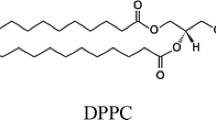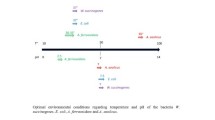Summary
The effects of fourteen sterols on the NMR spectra of liposomes derived from egg yolk phosphatidylcholines were studied by continuous-wave and Fourier-transform measurements at 60 MHz. Sterols were compared for their ability to broaden the acyl methylene resonances of phosphatidylcholine, when incorporated into liposomes at 25% molar ratio. The ratio of the phosphatidylcholine peak heights (acyl methylene: cholinen-methyl) was used as a criterion of the relative condensing activity for the different sterols. This ratio was inversely proportional to the molar volume of the incorporated sterol, as measured by the parachor of the compound. Small sterols had little condensing effect, and the larger sterols such as cholesterol and ergosterol had maximum condensing effects. The study confirmed the importance of the sterol side-chain at C-17 as a requirement for sterol-phospholipid interaction.
Similar content being viewed by others
References
Ahmad, P. 1977. Parachors in Drug Design: Structure-Activity Correlation Study of Steroids. Ph.D. Thesis, University of Guelph, Ontario, Canada
Ahmad, P., Fyfe, C.A., Mellors, A. 1975. Anti-inflammatory steroids, lysosomal stabilization and parachor.Can. J. Biochem. 53:1047
Ahmad, P., Mellors, A. 1976. Glucocorticoid potency and parachor.J. Steroid Biochem. 7:19
Bangham, A.D., Hill, M.W., Miller, N.G.A. 1974. Preparation and use of liposomes as models of biological membranes.In: Methods in Membrane Biology. E.D. Korn, editor. Vol. 1, p. 1. Plenum Press, New York
Butler, K.W., Smith, I.C.P., Schneider, H. 1970. Sterol structure and ordering effects in spin-labelled phospholipid multibilayer structures.Biochim. Biophys. Acta 219:514
Chapman, D., Penkett, S.A. 1966. Nuclear magnetic resonance spectroscopic studies of the interaction of phospholipids with cholesterol.Nature (London) 211:1304
Darke, A., Finer, E.G., Flook, A.G., Phillips, M.C. 1972. Nuclear magnetic resonance study of lecithin-cholesterol interactions.J. Mol. Biol. 63:265
DeKruyff, B., DeGreef, W.J., Van Eyck, R.V.W., Demel, R.A., Van Deenen, L.L.M. 1973. The effect of different fatty acid and sterol composition on the erythritol flux through the cell membrane ofAcholeplasma laidlawii.Biochim. Biophys. Acta 298:479
DeKruyff, B., Demel, R.A., Van Deenen, L.L.M. 1972. The effect of cholesterol and epicholesterol incorporation on the permeability and on the phase-transition of intactAcholeplasma laidlawii cell membranes and derived liposomes.Biochim. Biophys. Acta 255:331
Demel, R.A., Bruckdorfer, K.R., Van Deenen, L.L.M. 1972. Structural requirements of sterols for the interaction with lecithin at the air-water interface.Biochim. Biophys. Acta 255:311, 321
Huang, C. 1977a. A structural model for the cholesterol-phosphatidylcholine complexes in bilayer membranes.Lipids 12:348
Huang, C. 1977b. Configurations of fatty acyl chains in egg phosphatidylcholine-cholesterol mixed bilayers.Chem. Phys. Lipids 19:150
Lee, A.G., Birdsall, N.J.M., Levine, Y.K., Metcalfe, J.C. 1972. High resolution proton relaxation studies of lecithins.Biochim. Biophys. Acta 255:43
Papahadjopoulos, D., Kimelberg, H.K. 1973. Phospholipid vesicles (liposomes) as models for biological membranes: Their properties, and interactions with cholesterol and proteins.In: Progress in Surface Science. S.G. Davison, editor. Vol. 4 (part 2) p. 141. Pergamon Press, New York
Phillips, M.C., Kamat, V.B., Chapman, D. 1970. The interactions of cholesterol with the sterol-free lipids of plasma membranes.Chem. Phys. Lipids 4:409
Quayle, O.R. 1953. The parachors of organic compounds: An interpretation and catalogue.Chem. Rev. 53: 439
Suckling, K.E., Boyd, G.S. 1976. Interactions of cholesterol side-chain with egg lecithin: A spin label study.Biochim. Biophys. Acta 436:295
Taylor, J.L., Haydon, D.A. 1965. The interaction of progesterone with lipid films at the air-water interface.Biochim. Biophys. Acta 94:488
Yeagle, P.L., Hutton, W.C., Huang, C., Martin, R.B. 1975. Head-group conformation and lipid-cholesterol association in phosphatidylcholine vesicles: A31P(1H) nuclear Overhauser effect study.Proc. Nat. Acad. Sci. USA 72:3477
Yeagle, P.L., Hutton, W.C., Huang, C., Martin, R.B. 1976. Structure in the polar head region of phospholipid bilayers: A31P(1H) nuclear Overhauser effect study.Biochemistry 15:2121
Yeagle, P.L., Martin, R.B. 1976. Hydrogen-bonding of the ester carbonyls in phosphatidylcholine bilayers.Biochem. Biophys. Res. Commun. 69:775
Author information
Authors and Affiliations
Rights and permissions
About this article
Cite this article
Ahmad, P., Mellors, A. Nuclear magnetic resonance studies on liposomes: Effects of steroids on lecithin fatty acyl chain mobility. J. Membrain Biol. 41, 235–247 (1978). https://doi.org/10.1007/BF01870431
Received:
Issue Date:
DOI: https://doi.org/10.1007/BF01870431




